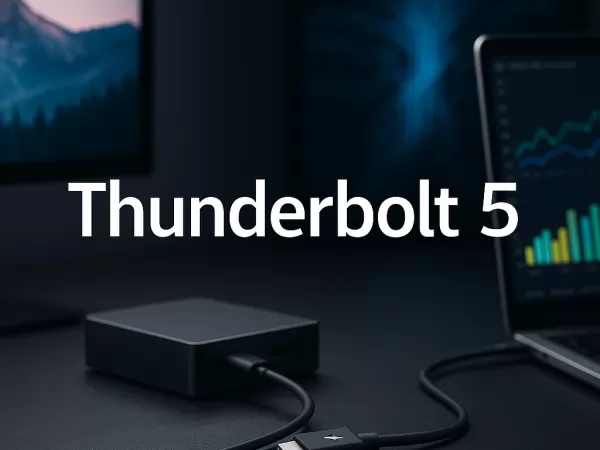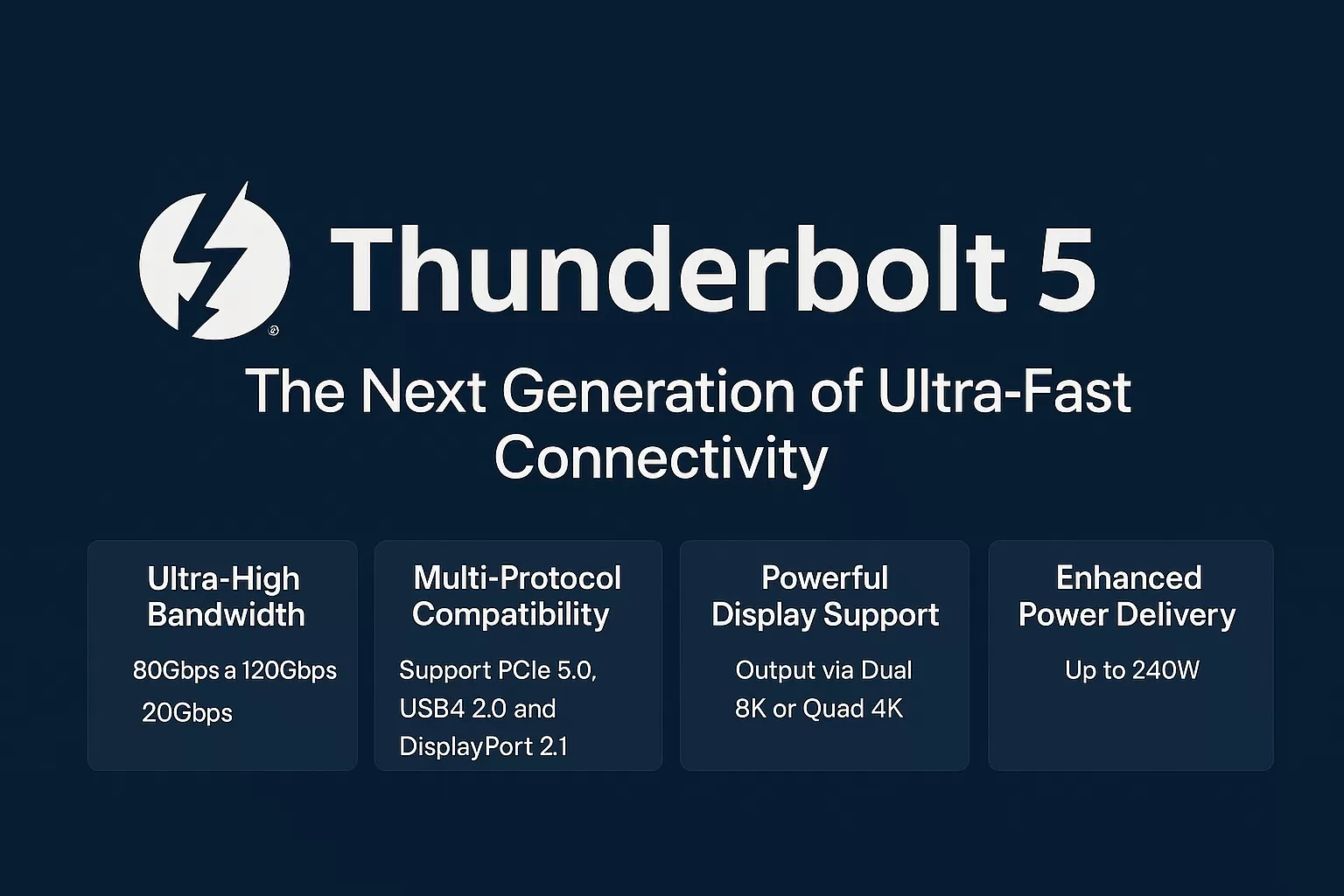Thunderbolt 5: The Next Generation of Ultra-Fast Connectivity

1. Introduction to Thunderbolt 5
Developed by Intel, Thunderbolt has long been a benchmark in high-speed connectivity and data transfer. Thunderbolt 5, officially launched in 2023, represents a major leap forward in both performance and versatility.
Retaining the compact USB-C form factor, it introduces an entirely new signaling architecture and advanced encoding technology that significantly boosts bandwidth and power delivery.
Fully backward-compatible with previous standards, Thunderbolt 5 delivers a seamless, powerful, and flexible connection experience for users across creative, gaming, and business environments.

2. Key Features of Thunderbolt 5
A. Ultra-High Bandwidth
Thunderbolt 5 supports two performance modes — 80 Gbps and up to 120 Gbps (for supported devices), doubling or even tripling the throughput of Thunderbolt 4’s 40 Gbps.
For creators handling large 4K or 8K video files, this means transfers in mere seconds, dramatically improving workflow efficiency.
B. Multi-Protocol Compatibility
Continuing the legacy of universal connectivity, Thunderbolt 5 is compatible with PCIe 5.0, USB4 2.0, and DisplayPort 2.1.
A single Thunderbolt 5 port can connect monitors, storage devices, and docking stations — simplifying workspace cabling while maintaining maximum speed.
C. Powerful Display Support
Thunderbolt 5 brings next-generation display capabilities:
It supports dual 8K @ 60 Hz or quad 4K @ 120 Hz output, ideal for professional designers and video producers.
With Display Stream Compression (DSC) under DisplayPort 2.1, users enjoy efficient, lossless visual transmission.
D. Enhanced Power Delivery
With up to 240 W of power delivery (PD), Thunderbolt 5 can charge high-performance laptops or mobile workstations through a single cable — handling both data and power without additional adapters.
E. Intelligent Bandwidth Management
Thunderbolt 5 features dynamic bandwidth allocation, automatically optimizing data routes based on device priorities.
For instance, when connecting both a display and storage drive, display data receives low-latency priority to ensure smooth visuals while sustaining fast data transfer speeds.
3. Generational Comparison
| Feature | Thunderbolt 3 | Thunderbolt 4 | Thunderbolt 5 |
|---|---|---|---|
| Max Bandwidth | 40 Gbps | 40 Gbps | 80 / 120 Gbps |
| Max Power Output | 100 W | 100 W | 240 W |
| Display Support | 2 × 4K or 1 × 8K | 2 × 4K or 1 × 8K | 4 × 4K or 2 × 8K |
| Data Protocols | PCIe 3.0, USB 3.1 | PCIe 4.0, USB4 | PCIe 5.0, USB4 2.0 |
| Display Protocols | DP 1.4 | DP 1.4 | DP 2.1 (DSC) |
Compared with Thunderbolt 4, Thunderbolt 5 offers up to 3× the bandwidth, 2.4× the power output, and expanded multi-display support, setting a new standard for professional and consumer connectivity.
4. Who Benefits from Thunderbolt 5
(A) Professional Creators
Video editors, 3D artists, and photographers can transfer massive files instantly and power multiple 8K displays for efficient multi-task workflows.
(B) Gamers
Gamers can connect external GPUs via Thunderbolt 5 docks, unlocking desktop-level graphics performance on laptops.
Its multi-display support enhances immersive gaming setups.
(C) Enterprise IT Managers
Simplified connectivity means fewer cables, easier device management, and reduced maintenance costs — all while delivering enterprise-grade data performance.
(D) Mobile Professionals
Thunderbolt 5 enables true one-cable docking for displays, peripherals, and fast charging — perfect for business travelers needing instant, clutter-free setups.
5. Buying Guide: Choosing Thunderbolt 5 Products
A. Verify Compatibility
Ensure your host device supports Thunderbolt 5.
As of 2025, major PC manufacturers are expanding Thunderbolt 5 adoption across flagship laptops and desktops.
B. Match Your Use Case
Creators → choose high-bandwidth, multi-display docks.
Gamers → opt for docks supporting eGPU connections.
Mobile users → select lightweight, travel-friendly hubs.
C. Check Core Specifications
Compare supported bandwidth (80 Gbps / 120 Gbps), power delivery (W), and display output (resolution + refresh rate) before purchase.
D. Review Port Options
Confirm your dock offers the necessary USB-A / C, HDMI, SD card reader, Ethernet, or other I/O to suit your workflow.
E. Consider Brand & Value
Reputable brands ensure reliability, safety, and post-sale service.
wfyear Thunderbolt 5 solutions deliver high-performance connectivity built to professional standards — with competitive pricing for every user segment.
6. Frequently Asked Questions
Q1. Is Thunderbolt 5 backward-compatible?
Yes. Thunderbolt 5 devices are fully compatible with Thunderbolt 4 and Thunderbolt 3 devices, operating at the older standard’s speed.
Q2. What’s the difference between Thunderbolt 5 and USB4 2.0?
Thunderbolt 5 is built upon USB4 2.0 architecture but supports higher bandwidth (120 Gbps vs 80 Gbps), intelligent bandwidth routing, and enhanced power delivery.
Q3. Do Thunderbolt 5 docks require external power?
Some can deliver up to 240 W through a single cable; others may require an external power adapter depending on device power needs.
Q4. Does Thunderbolt 5 support external GPUs?
Absolutely. The increased bandwidth allows near-desktop GPU performance through compatible eGPU docks.
Q5. Are Thunderbolt 5 cables different from USB-C cables?
Yes. To reach full performance, use certified Thunderbolt 5 cables, which are engineered to handle higher data and power loads than standard USB-C cables.
Conclusion
As the demand for next-generation connectivity continues to grow, Thunderbolt 5 stands as a game-changer — merging speed, power, and versatility into a single unified interface.
wfyear will continue to integrate Thunderbolt 5 technology into our future docking stations, cables, and high-performance accessories, empowering creators, gamers, and professionals worldwide.